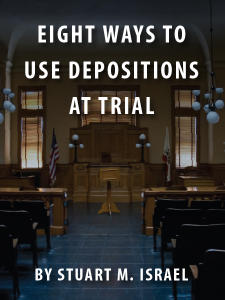Ultimately, you may find yourself in trial, with your collection of transcripts of depositions taken months and even years earlier. What can you do with them?
Federal Rule of Civil Procedure (Rule) 32(a)(1) permits the use of “all or part of a deposition” at trial “to the extent it would be “admissible” under the Federal Rules of Evidence “if the deponent were present and testifying” under the various circumstances set out in Rule 32(a)(2)-(8). A deposition may be used “against a party” who was “present or represented at the taking of the deposition” or who had “reasonable notice” of the deposition for various purposes. These purposes include using deposition testimony at trial (1) to present admissions; (2) for impeachment; (3) as a substitute for “unavailable” witnesses; (4) to refresh recollection; (5) as a substitute for unrefreshed memory; (6) as past recollection recorded; (7) for witness control; and (8) to make offers of proof and to support or resist evidentiary motions and objections

1. To present admissions
The deposition of a party—or a party’s officer, director, managing agent or other Rule 30(b)(6) representative—may be used at trial for “any purpose.” Rule 32(a)(3). So deposition testimony can be used to present party admissions—admissions by an “opposing party” that meet the standards set by Fed. R. Evid. 801(d)(2).
Opposing party admissions include the party’s statements, statements adopted or endorsed by the party, statements authorized by the party, and statements by the party’s agents and employees made within the scope of agency or employment during the relationship. Opposing party admissions are excluded from the definition of hearsay, and may be used as substantive evidence against the party. Fed. R. Evid. 801(d)(2).
How and when deposition admissions are presented at trial is left to the creative judgment of the presenting lawyer, subject to the judge’s Fed. R. Evid. 611(a) authority over presentation of evidence and to the “rule of completeness” under Rule 32(a)(6) and Fed. R. Evid. 106.
Deposition admissions can be presented with or without a witness. If used while the admitter is on the stand (even remotely), the presenting lawyer can, but is not obligated to, show the transcript to the witness or permit the witness to explain or elaborate; party admissions are excepted from the Fed. R. Evid. 613(b) extrinsic evidence prerequisites which govern presentation of prior inconsistent statements by non-party witnesses.
The Practical Lawyer

CLICK HERE for the free download of the full article, which was originally published in ALI CLE’s The Practical Lawyer.
Subscribe to the print or digital version of The Practical Lawyer today.
